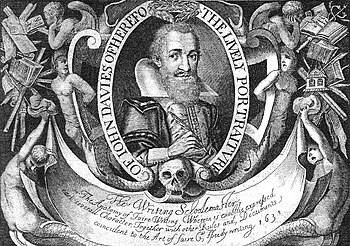
John Davies of Hereford (c. 1565 – July 1618) was a writing-master and an Anglo-Welsh poet. He referred to himself as John Davies of Hereford (after the city where he was born) in order to distinguish himself from others of the same name, particularly the contemporary poet Sir John Davies (1569–1626).
Davies wrote very copiously on theological and philosophical themes, some of which brought proto-scientific ideas into the public arena.[1] He also wrote many epigrams on his contemporaries which have some historical interest. John Davies died in London.
Davies was a friend of Edmund Ashfield, and wrote in an epigram that he nearly accompanied Ashfield on his journey to Scotland in 1599.[2]
- ^ Sawday, Jonathan (1995). "6 THE UNCANNY BODY". The Body Emblazoned. London: Routledge. p. 144. ISBN 0-415-15719-6.
In a series of long poetico-philosophical treatises - Mirum in Modum (1602), Microcosmos (1603), Summa Totalis (1607) - Davies of Hereford presented his vision of a harmonized science of the universe and the human body. These three texts, taken together, formed a unified project, a vast syncretic enterprise which surveyed all of human knowledge in an effort to achieve a theologically ordered prospectus of the world.
- ^ Henry Alfred Napier, Historical Notices of the Parishes of Swycombe and Ewelme (Oxford, 1858), pp. 358-9.
